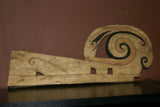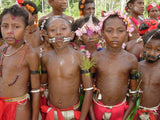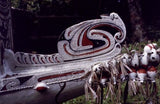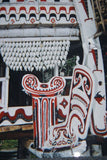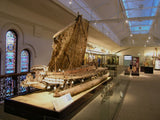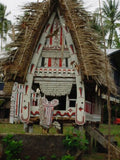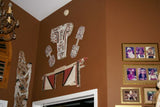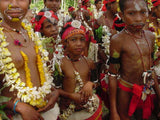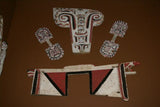EXTREMELY RARE SOUTH PACIFIC OCEANIC ART PROW BOARD TABUYA WAVE SPLITTER FROM SEAFARING CANOE, TROBRIAND ISLANDS MELANESIA PNG. HAND CARVED WOOD CIRCA 1950 SUCH ARE SEEN IN MUSEUMS DISPLAYING ARTIFACTS FROM REMOTE CULTURES DESIGNER COLLECTOR TAB8
Very old piece.
Fine condition
Authentic hand carved maritime collectible.
They normally retail, when they can be found, between $600.00 and up to $1,000.00 (we are asking a fraction of the original value)
VERY RARE
Item: TAB8
Size: 20 3/4" X 8 1/2"
PROW BOARD/DOGINA/TABUYA
WE HAVE SOLD THESE RARE ITEMS TO MUSEUMS AROUND THE WORLD
On photos 10 and 12, you see some of this wonderful and rare art displayed in our home.
ITEM: TAB8 (SEEN ON PHOTOS 1 AND 3)
Other photos show how those magnificent sea going canoes were outfitted with these rare collectible wooden carvings and where these different parts fit within the vessel, also some of the natives.
Extremely Rare Tabuya or wavesplitter from the Trobriand Islands, Papua New Guinea.
Made by a canoe builder & expert carver long ago, this unusual wooden piece shows the characteristic ornate Trobriand decorative style.
These old and scarce Canoe parts that we collected over the last 35 years are scarce, hard to locate, and not allowed for exportation out of P.N.G today. We are selling out our personal collection of nautical and marine artifacts, accumulated for decades, as we are retiring into a smaller home and have no additional room anymore.
All such intricate and very rare canoe parts are extremely hard to locate and are seen today in a few museums around the world. We are fortunate to own a collection of them, lagim, tabuyas, oars and other old nautical items from this remote and little visited region, part of the Kula trade, since they cannot be exported today.
The tabuya or wave splitter, for sale here, is mortised into the canoe nose and acts as a knee holding the lagim and the sideboards in place. These boards embody the principal art of the canoe, but are strictly functional in their origin.
Sea-going canoes are central to the kula trading system of the Trobriand Islands, that we will explain below as well, and a finely decorated vessel enhanced the prestige of the members of a trading expedition and of their village.
The canoes are an important part of Kula: Without them there would be no Kula as the communities could not come together across the seas. The waga (canoes) used in Kula are quite different from the canoes used to fish around the village. Their sheer size makes them stand out. They have been developed specifically to enable travel across large distances. In each waga approximately 15 men can travel comfortably. The lagim (splashboard) on the bow of each canoe is carved and painted. The symbols on the lagim show the importance of the waga. A bwalai (small man figure) represents the spirit of the man in charge of the canoe and allows his spirit to search the ocean. Minudoga (Sandpipers), the seabird that floats on the ocean, symbolizes the care that must be taken by the leader for his crew and his community. He will push them to the extreme but must also be aware of their physical well being. Kaitari, the enchantment of the waves and the tides is a link to the sea and if you are in Kula you must remind yourself of its power.
Kula is a ritualized trading culture existing in eastern Papua New Guinea.
It is essentially network of villages joined by a common trade route, known as the Kula Circle.
Nearly a century ago, it was predicted that Kula, the exchange of shell valuables in the Massim region of Papua New Guinea, would disappear, yet Kula was then and still remains a life sustaining cultural exchange today, although the intricate pattern in which traditional values, once the foundations that enabled a healthy and peaceful survival, are based is slowly eroding, even in these remote Trobriand islands.
Kula: There are many deep motivations and meanings that lie behind the pursuit of Kula. The visually stimulating designs, carved and painted on the lagims and prowboards that decorate canoes used by the Kula voyagers, comprise layers of encoded meaning. The unique color associations and other formal elements speak of key emotional issues within the people’s everyday and spiritual lives. Messages conveyed by the canoe boards converge with those presented in Kula myths and rituals.
This Kula system of exchange involves annual inter-island visits between trading partners who trade highly valued shell ornaments.
These ornament were passed from island to island in a counter-clockwise direction. Kula is a ritualized trading culture still existing in eastern Papua New Guinea. It is essentially a network of villages joined by a common trade route, known as the Kula Circle. Kula is the basis of mental and physical well-being. The Kula Circle has always been associated with making contact with far off neighbors. Traditionally two kinds of items were traded; arm bands carved from the sea shell known as Mwali and spondylus shell necklaces, Soulava. Each of these items were traded individually. Mwali and Soulava traveled in opposite directions around the Kula Circle (group of islands). Mwali passed anticlockwise in the ring and were given with the right hand, the Soulava passed clockwise and with the left hand, first between villages then from island to island.
Check Dominique Rice Oceania Store in Sun Sentinel Newspaper, Fort Lauderdale, for information on our collection and authentic art.
All our collector and rare items come with pages and pages of research about provenance, and with history of the tribes and photos as well, depending on item and whenever possible.
When shipping internationally, we group ship multiple purchases to save you money, and find the best rates available. If you have any questions or want to see research conducted on this piece and photos of tribes, let us know.
We have artifacts and architectural accents up to 10 ft tall that we will put on upon request because shipping has to be calculated accordingly with trucking company.












